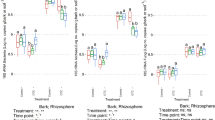Abstract
Hericium is an edible, highly sought after wood rotting fungus of temperate deciduous forests. There is little or no commercial forest production on wood substrates, unlike shiitake for which there is considerable commercial demand. There are no detailed descriptions of production practices, and very few commercially available strains. This study compared yield of mushrooms from four different strains—one commercial, Hericium erinaceus and three strains of H. americanum isolated locally (upstate NewYork). Each strain was inoculated onto totem stacks of American beech (Fagus grandifolia) and mushroom production was monitored for five years. There were differences among strains in the percentages of totems that fruited over the five year duration of the experiment. Significantly fewer logs fruited of the commercial strain compared to the locally isolated strains. There were no significant difference among the four strains with respect to the yield of mushroom per log, but yield varied significantly depending on the number of years after inoculation, with peak production during the third and fourth years. Peak production levels were similar to the commercial yield of forest cultivated shiitake mushrooms. The successful forest production of Hericium mushrooms on totem stacks, and the yield potential demonstrated here suggest that this non-timber forest crop may be suitable for commercial production.



Similar content being viewed by others
References
Abdulla MA, Noor SM, Sabaratnam V, Abdullah N, Wong KH, Ali HM (2008) Effect of culinary-medicinal Hericium mushroom, Hericium erineceus (Bull.:Fr.)Pers. (Aphyllophoromycetideace), on ethanol-induced gastric ulcers in rats. Int J Med Mushrooms 10:325–330
Cotter T (2014) Organic mushroom fruiting and mycoremediation. Simple to advanced and experimental techniques for indoor and outdoor cultivation. Chelsea Green Publishers, White River Junction
Figlas D, Matute R, Curvetto N (2007) Cultivation of culinary-medicinal Hericium mushroom Hericium erinaceus (bull.:Fr.) Pers. (Aphyllophoromycetideae) on substrate containing sunflower seed hulls. Int J Med Mushrooms 9:67–73
Gold MA, Cernusca MM, Godsey LD (2008) A competitive market analysis of the United States Shiitake mushroom marketplace. HortTechnology 18:489–499
Grace J (2010) An evaluation of local isolates of Hericium americanum for use in mushroom production. M.S. Thesis, Cornell Univerisity, Ithaca
Hobbs C (1995) Medicinal mushrooms an exploration of tradition, healing and culture. Botanica Press, Santa Cruz Ca
Kou M (2004) The genus Hericium, Retrieved Sept 2014 from http://mushroomexpert.com/Hericium.html
Moldavan MG, Gryganski AP, Kolotushkina OV, Kirchhoff B, Skibo G, Pedarzani P (2007) Neurotropic and tropic action of Hericium mushroom Hericium erinaceus (Bull.:Fr.) pers. (Aphyllophoromycetideae) extracts on nerve cells in vitro. Int J Med Mushrooms 9:15–28
Mudge KW, Gabriel S (2014) Farming the woods. An integrated permaculture approach to growing food and medicinals in temperate forests. Chelsea Green Publisher, White River Junction
Mudge KW, Matthews A, Waterman B (2013) Best management practices for log-based shiitake cultivation in the Northeastern United States, NE SARE project LNE10-298, Cultivation of shiitake mushrooms as an agrofrorestry crop for New England., Burlington, VT
Royse D (1999) Specialty mushrooms and their cultivation. Hortic Rev 19:59–93
Stamets P (2005) Mycellium running. Ten Speed Press, Berkeley CA
Uhart M, Piscera J, Alberto E (2008) Utilization of new naturally occurring strains and supplementation to improve the biological efficiency of the edible mushroom, Agrocybe cylindracea. J Ind Microbiol Biotechnol 35:595–602
USDA, National Agricultural Statistical Service. ISSN: 1949-1530, 20 Aug 2013. http://usda01.library.cornell.edu/usda/current/Mush/Mush-0820-2013.pdf
Wasser SP (2002) Medicinal mushrooms as a source of antitumor and immunomodulating polysaccharides. Appl Microbiol Biotechnol 60:258–274
Wasser SP, Weis AL (1999) Medicinal properties of substances occurring in higher basidiomycetes mushrooms: current perspectives. Int J Med Mushrooms 1:31–62
Acknowledgements
The authors wish to thank Rachel Brinkman, Joe Lardner, and Tim Putzke for field and laboratory assistance, Francoise Vermeylen for statistical advice.
This work is/was supported by the USDA National Institute of Food and Agriculture, McIntire Stennis Projects 0216583, NYC 145512, and 0231359, NYC 145500. Any opinions, findings, conclusions, or recommendations expressed in this publication are those of the author(s) and do not necessarily reflect the view of the National Institute of Food and Agriculture (NIFA) or the United States Department of Agriculture(USDA).
Author information
Authors and Affiliations
Corresponding author
Rights and permissions
About this article
Cite this article
Grace, J., Mudge, K.W. Production of Hericium sp. (Lion’s Mane) mushrooms on totem logs in a forest farming system. Agroforest Syst 89, 549–556 (2015). https://doi.org/10.1007/s10457-015-9790-1
Received:
Accepted:
Published:
Issue Date:
DOI: https://doi.org/10.1007/s10457-015-9790-1




